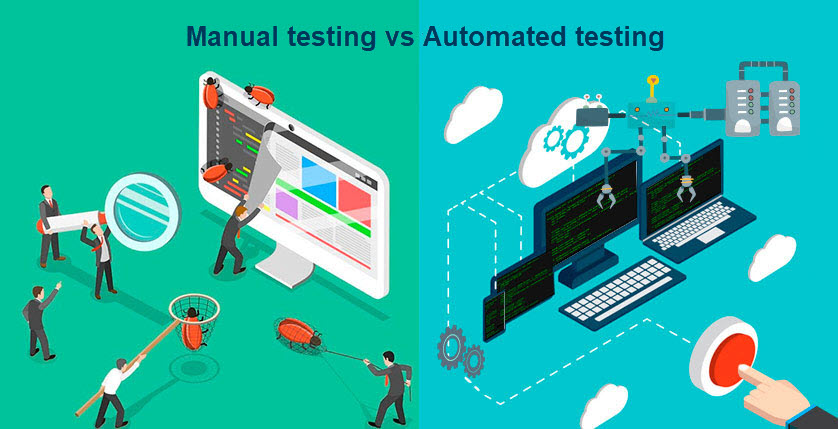People often compare manual and automated testing. Both ways of testing have their own advantages and disadvantages.
Manual testing vs Automated testing
- 24.05.2022
- Posted by: Admin

Some main advantages of automated testing are its speed and absence of the human factor so it is what made it so widely accepted. It seems that automatization testing is applied for most tasks and it can substitute and push off the work of the manual testers in the near future.
However, QA engineers of web sites, desktop and mobile software testers reassure that it won’t happen because there are aspects of work that the tool cannot deal with alone, it needs a professional, a human being.
Situations where manual testing prevails over automated testing:

- testers can decide which areas to test and whether to perform tests that are not included as automated ones, in such way to increase the test coverage and find bugs that the tool wouldn’t be able to find;
- testers see defects that weren’t meant by the automated tests. One cannot predict everything, testing engineers can improvise but tools are not capable of this;
- tools cannot have feelings that the end users may have, that is why they are not efficient in terms of the previous experience and intuition. Only a human being can fully evaluate the software, when the tool only decides whether the software passes the tests.
Automated testing presupposes the interaction between the software and tools with a minimum amount of human interference.
Automation tools are useful for different types of activities. They save time performing the regression, unit, load and other types of testing.
Processes that can be automated:
- regression testing;
- smoke testing;
- performance testing;
- load testing;
- white box testing (with the help of the unit testing tools);
- code coverage analysis.
However the biggest mistake of the developers is the automatisation of the wrong processes during the software development. Not everything can be programmed and performed automated.
What shouldn't be automated:
- unstable program software. If the product is on the development stage and is constantly changed, automated testing is not an efficient way to test.
- rare testing scenarios. It’s better not to automate cases that will be run rarely;
- program code analysis and documentation. Automation testing of these processes can cause troubles in the future.
Usually, automated testing is applied to the repeating task. That is why some companies decide to use manual testing first in order to find out what process will be done more than one time, in order to automate them in the future.
Situations where automated testing prevails over manual testing:

- the script can be performed a lot of times;
- autotests are performed with the bigger accuracy because the human factor is excluded;
- the time for performing autotests is much shorter than performing the same checks manually;
- the test run can be scheduled at any time, run on schedule so that it is performed without human intervention.
Scenarios where automated testing can be applied:
- hard-to-reach areas in the system;
- functionality that is often used, in which the risk of defects is quite high;
- routine tasks such as data analysis;
- validation messages checks;
- long end-to-end scenarios;
- verification of data that require accurate mathematical calculations.
Both types of testing have their both advantages and disadvantages. Real projects often use a combination of manual and automated testing and the level of automation depends on both the type of project and the characteristics of production processes in the company. The combination of both types is the perfect way to get the most out of testing.


